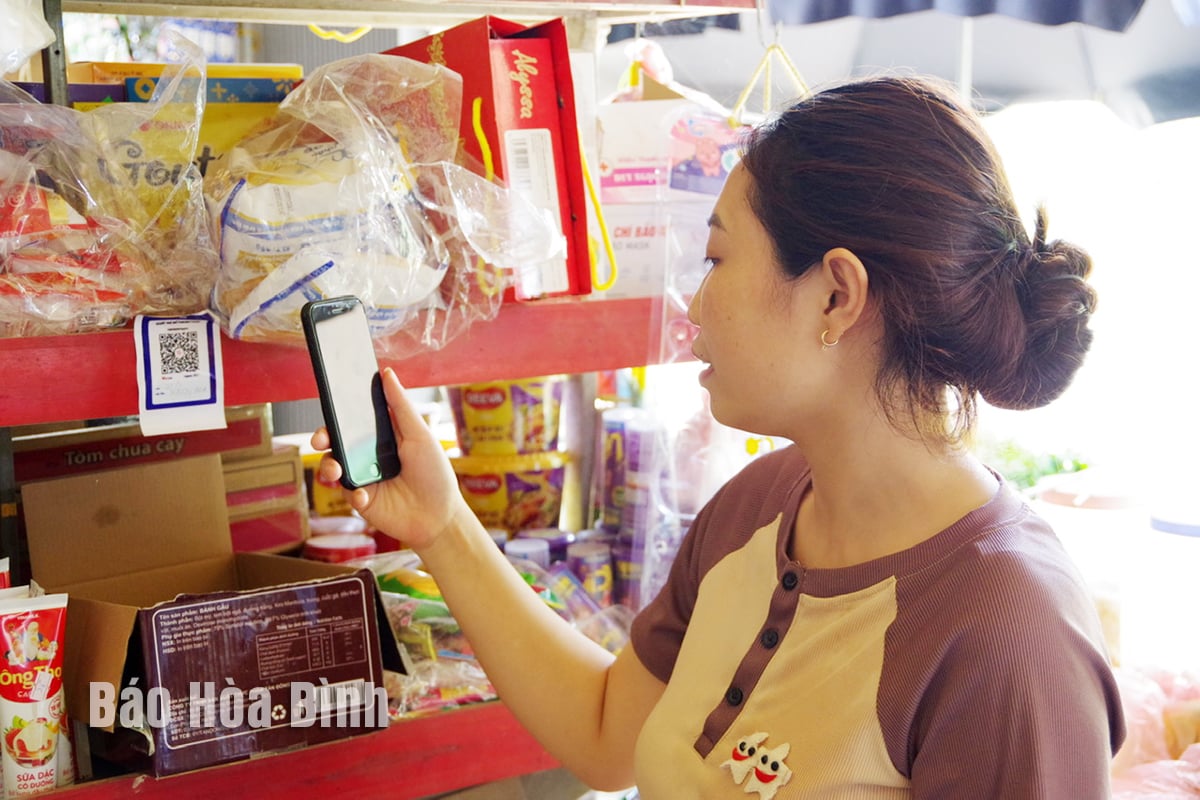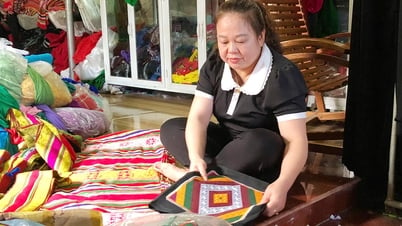People use cashless payment methods when shopping at grocery stores in Vay Nua commune (Da Bac).
"Digital citizens" in remote villages
"When the shop first opened, people paid in cash. At that time, only a few people in the village had bank accounts, mainly for their children, spouses, and relatives working far away to send money back to their families. But now things are very different, the elderly receive their pensions via card, and young people transfer money via phone. Every day, my shop has dozens of customers using QR codes to pay," Ms. Hong happily said.
The change in consumption habits and use of e-commerce payment methods of Vay Nua people is not unique. This is part of the shift in the digital transformation wave that has been spreading throughout the province. Just a few years ago, bank accounts in remote families like Vay Nua were only used to "receive money" from relatives working far away. People with bank accounts were once likened to "living ATMs" of the village. But now many people, especially the young, pensioners, social welfare beneficiaries... all own personal accounts and are proficient in using digital banking services.
According to statistics from the State Bank of Vietnam, Region III Branch, up to now, the rate of adults with bank accounts in Hoa Binh province has reached 78.3%. 100% of budget spending units make payments through personal accounts. This is a big step forward in the digital transformation journey of the local banking sector. Commercial banks also actively coordinate with the Social Insurance, Post Office , and local authorities to pay pensions and subsidies through accounts. Not only is it a reform of administrative procedures, this activity contributes to spreading the form of e-commerce to disadvantaged areas.
Currently, the province has 9 commercial banks, 1 social policy bank, 30 provincial branches, 50 district transaction offices and 3 people's credit funds in operation. The infrastructure supporting digital payments has also expanded strongly with 73 ATMs, 492 POS machines, covering many communes and towns. Up to now, not only shops and business households but also many shippers and traders at traditional markets have become familiar with scanning QR codes and transferring money via Internet Banking and Mobile Banking. Modern payment methods, once considered "luxury" in rural areas, have now become popular choices.
The average growth rate of e-commerce transactions in the province over the past 3 years (2022 - 2025) is impressive with the number of transactions increasing by about 50%/year, transaction value increasing by about 20%/year. In particular, e-commerce transactions via mobile phones increased by 70%/year. Payment by QR code doubled every year. Notably, the whole province has about 700,000 people aged 15 and over using bank accounts or payment service providers, accounting for more than 2/3 of the province's population.
Risks go hand in hand with convenience
According to the assessment of the authorities, along with the strong development of e-commerce methods are challenges to financial security. Statistics from 2023 to present, the provincial police force has received information about nearly 50 cases of fraud and appropriation of assets on cyberspace, the amount of money appropriated is up to tens of billions of VND. In most of the cases, the fraudsters used fake accounts, rented accounts to receive money from the victims and then transferred it to other accounts to erase traces.
Along with the development of technology, scams are also becoming more sophisticated. Some common tricks include: impersonating police officers, the Procuracy, tax authorities... asking people to install fake applications and transfer money; recruiting online sales collaborators, delivering fake orders to lure victims to transfer money; setting up fake websites of banks and financial companies advertising loans with quick procedures and then appropriating fees; using deepfake technology, AI impersonating voices and faces of relatives to request money transfers. In addition to the above tricks, recently there has been a situation where subjects set up "ghost" businesses, opened bank accounts to receive money from investment platforms, virtual currencies... and then appropriated them. The victims are mostly people who lack understanding of digital transactions or use social networks, smartphones, and do not have basic knowledge of security.
Faced with that situation, banks in the province have deployed advanced security measures, such as multi-factor authentication (OTP, biometrics, facial recognition), user data encryption, using blockchain technology to protect transaction integrity, and deploying real-time fraud monitoring systems.
According to the assessment of the authorities, high-tech crimes related to banks are becoming more and more complicated. Although banks have been applying many technologies to protect customers, fighting fraud using AI is still a challenge. Currently, many banks have integrated risk warnings as soon as users perform unusual operations, proactively sending authentication notifications if they see logins from strange devices. However, effectiveness still depends largely on the vigilance and understanding of users.
According to Lieutenant Colonel Nguyen Cao Cuong, Head of the Department of Cyber Security and High-Tech Crime Prevention, Provincial Police: To contribute to ensuring safety in e-commerce activities, in addition to upgrading security from the bank side, the most important thing is to raise awareness, digital skills along with "digital intelligence", which is understanding, vigilance and initiative from the people. At that time, each smartphone is not only a payment tool, but also a door to bring people closer to a transparent and modern digital society.
Manh Hung
Source: https://baohoabinh.com.vn/12/202252/Thanh-toan-khong-dung-tien-mat-buoc-tien-tr111ng-chuyen-doi-so.htm




![[Photo] Close-up of modernized Thu Thiem, connecting new life with District 1](https://vphoto.vietnam.vn/thumb/1200x675/vietnam/resource/IMAGE/2025/6/24/d360fb27c6924b0087bf4f288c24b2f2)



![[Photo] The 9th Party Congress of the National Political Publishing House Truth](https://vphoto.vietnam.vn/thumb/1200x675/vietnam/resource/IMAGE/2025/6/24/ade0561f18954dd1a6a491bdadfa84f1)





























































































Comment (0)